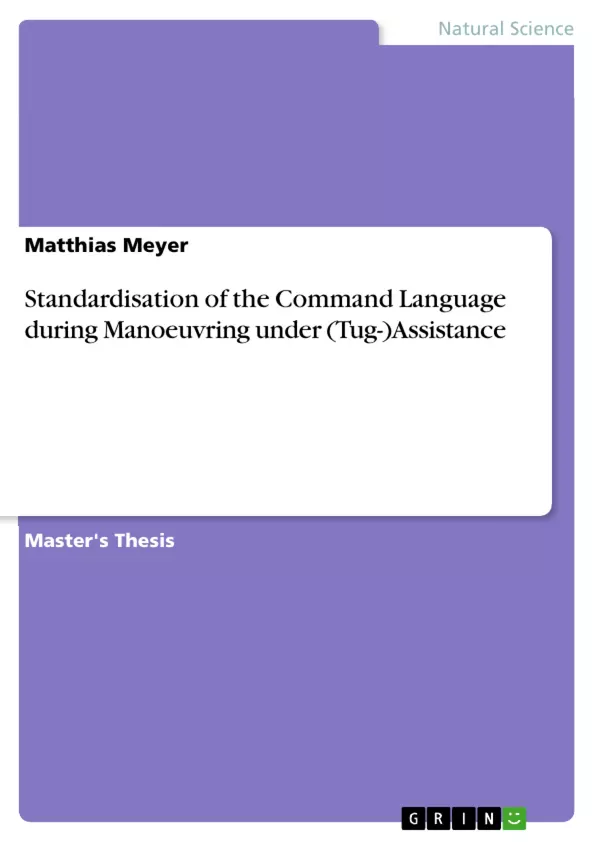The topic of the dissertation is the supplementation of the existing IMO SMCPs with the commands necessary for manoeuvring under tug assistance. For this purpose a number of English language commands have been developed which allow safe manoeuvring of tug assisted vessels in all ports and countries.
The dissertation shows the most important international and national (for Germany) legal provisions according to which the captain of the vessel to be piloted and the Bridgeteam have to be informed at all times about the commands given by the pilot to the assisting tugboats or their captains via VHF radio communication.
Finally, the conclusion elaborates on the need for a common command language and demonstrates the need for the insertion of these commands in the appropriate place in the SMCPs.
The Maritime Safety Committee of the International Maritime Organization (IMO) decided in 1973 to use the English language in shipping for communication. In 1977 the Standard Marine Navigational Vocabulary (SMNV – IMO Resolution A380.(10)) was developed and adopted, and in 1985 amended.
After a period of application, the IMO Standard Marine Communication Phrases - SMCPs -were implemented in international law with the adoption of IMO Resolution A1.918(22) by the 22nd Assembly in November 2001. Today, the SMCPs are used in the shipping industry and are the basis for the training of nautical officers in accordance with the International Convention on Standards of Training, Certification and Watchkeeping for Seafarers (STCW).
According to the International Convention for the Safety of Life at Sea - SOLAS, a common language shall be used on ships to which the Code applies. This is particularly true about the master's responsibility and authority to make decisions, e.g. with regard to manoeuvring with tugs.
As there are no uniform commands for manoeuvring under tug assistance in the SMCPs, these commands are given in the respective national language or in a non-uniform working language. This circumstance prevents the master from being able to understand the communication between pilots and the assisting tugboat captain at any time and, if necessary, from intervening accordingly.
Inhaltsverzeichnis (Table of Contents)
- Introduction
- Critical review of the literature and publications
- German Pilotage System and the Law
- Minimum requirements for an apprentice according to the German law
- Definition of the term manoeuvring elements
- The use of manoeuvring elements
- The working language and the obligations of the shipmaster, bridge team, and pilot
- The general duty of the pilot to give advice, and the supervision by the shipmaster and ship's officers
- Pilot's carrying out the pilotage with the assistance of tugs
- Use of VHF radiotelephony for transmission of commands on the bridge in German (or any other language)
- Discussion of manoeuvring terminology
- Proposals: Command-language for manoeuvring ships under tug assistance
- The vessel
- Towing direction
- Use of tug names
- Communication between the vessel and the tugs
- Standard Engine Orders for the assisting tug
- Tug commands/illustrated
- Make fast tug!
- Let go!
- Slack away line!
- Shorten the line!
- Slack line!
- Pull / Lift!
- Pull through!
- Follow!
- Slow down!
- Stop!
- Stand by!
- Attention!
- Lay back alongside!
- Push!
- Clearance?
- Manoeuvring with tugs - Examples and Commands
- Departure
- Departure with two tugs
- Turning
- Berthing manoeuvre
Zielsetzung und Themenschwerpunkte (Objectives and Key Themes)
This thesis explores the standardization of the command language during maneuvering under tug assistance, aiming to create a comprehensive and practical guide for maritime professionals involved in such operations. It investigates the existing command language practices, identifies potential challenges, and proposes a standardized approach to improve communication and safety.
- Standardization of command language for tug assistance operations
- The importance of clear and unambiguous communication in maneuvering under tug assistance
- Review and analysis of existing command language practices in different regions and jurisdictions
- Development of a standardized command language system for tug assistance operations
- Implementation and practical application of the proposed standardized system
Zusammenfassung der Kapitel (Chapter Summaries)
- The introduction provides an overview of the topic, outlining the importance of standardized command language in tug assistance operations and the rationale for this study. It also presents the scope and structure of the thesis.
- This chapter presents a critical review of the existing literature and publications related to the topic, analyzing existing command language systems, best practices, and related research. It examines the historical development of command language standardization and the evolution of relevant regulations and guidelines.
- This chapter discusses the German Pilotage System and its legal framework. It provides details on the minimum requirements for apprentices, the definition of manoeuvring elements, and the working language used in pilotage operations. The chapter also examines the roles and responsibilities of the shipmaster, bridge team, and pilot in relation to the use of tug assistance during maneuvering.
- This chapter explores the various proposals for standardizing command language for manoeuvring ships under tug assistance. It covers the specific terminology used for the vessel, towing direction, tug names, communication between the vessel and the tugs, and standard engine orders for the assisting tug. This chapter also includes a detailed illustration of common tug commands and their respective explanations.
- This chapter focuses on providing real-world examples of maneuvering with tugs and illustrates the application of the proposed standardized command language. It includes scenarios such as departure, departure with two tugs, turning, and berthing maneuvers, showcasing the effectiveness of the standardized system in different operational contexts.
Schlüsselwörter (Keywords)
Tug assistance, command language, standardization, maritime communication, maritime safety, maneuvering, pilotage, VHF radiotelephony, bridge team, shipmaster, tugmaster, international regulations, best practices.
- Quote paper
- Matthias Meyer (Author), 2020, Standardisation of the Command Language during Manoeuvring under (Tug-)Assistance, Munich, GRIN Verlag, https://www.grin.com/document/1364337



